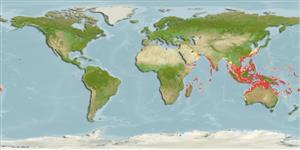Actinopterigi (pesci con pinne raggiate) >
Perciformes (Perch-likes) >
Lutjanidae (Snappers) > Lutjaninae
Etymology: Lutjanus: Malay, ikan lutjan, name of a fish.
Ambiente / Clima / Range
Ecologia
; marino; salmastro associati a barriera corallina; distribuzione batimetrica 12 - 100 m (Ref. 55). Tropical, preferred 27°C (Ref. 107945); 33°N - 33°S, 43°E - 178°W
Indo-West Pacific: Persian Gulf and Arabian Sea to Fiji, north to southern Japan, south to Australia. This species has been frequently misidentified as Lutjanus sanguineus (Ref. 55). There are unsubstantiated reports of this species from off East Africa.
Length at first maturity / Size / Peso / Age
Maturity: Lm 57.6, range 54 - ? cm
Max length : 100.0 cm TL maschio/sesso non determinato; (Ref. 55); common length : 50.0 cm TL maschio/sesso non determinato; (Ref. 55); Peso massimo pubblicato: 7.9 kg (Ref. 4699); Età massima riportata: 31 anni (Ref. 46527)
Spine dorsali (totale): 11; Raggi dorsali molli (totale): 12-14; Spine anali 3; Raggi anali molli: 8 - 9.
Adults inhabit both coastal and offshore reefs. They tend to be associated with sponge and gorgonian-dominated habitats on the North West Shelf (Ref. 28006), and hard mud areas of the Arafura Sea. In Australia, they frequently form mixed shoals with L. erythropterus. Juveniles tend to inhabit shallow inshore waters and larger fish live in deeper waters (Ref. 27260, 27264). Feed mainly on fishes, with small amounts of benthic crustaceans, cephalopods and other benthic invertebrates (Ref. 6390). They forage mostly at night (Ref. 6390). Marketed fresh, dried-salted (Ref. 55) and frozen (Ref. 9987).
Are batch or serial spawners (Ref. 28009).
Allen, G.R., 1985. FAO Species Catalogue. Vol. 6. Snappers of the world. An annotated and illustrated catalogue of lutjanid species known to date. FAO Fish. Synop. 125(6):208 p. Rome: FAO. (Ref. 55)
IUCN Red List Status (Ref. 115185)
CITES (Ref. 94142)
Not Evaluated
Threat to humans
Harmless
Human uses
Pesca: elevato interesse commerciale; Pesce da pesca sportiva: si; Acquario: Commerciale
Informazioni ulteriori
CollaboratoriImmaginiStamps, CoinsSuoniCiguateraVelocitàModalità di nuotoArea branchialeOtolithsCervelliVista
Strumenti
Special reports
Download XML
Fonti Internet
Estimates of some properties based on models
Phylogenetic diversity index (Ref.
82805): PD
50 = 0.5000 [Uniqueness, from 0.5 = low to 2.0 = high].
Bayesian length-weight: a=0.01514 (0.01320 - 0.01735), b=2.98 (2.95 - 3.01), in cm Total Length, based on LWR estimates for this species (Ref.
93245).
Trophic Level (Ref.
69278): 4.5 ±0.5 se; Based on diet studies.
Resilienza (Ref.
69278): Basso, tempo minimo di raddoppiamento della popolazione 4.5 - 14 anni (K=0.12-0.18; tmax=12; Fec=5,000,000).
Prior r = 0.49, 2 SD range = 0.19 - 1.29, log(r) = -0.71, SD log(r) = 0.48, Based on: 2 M, 12 K, 3 tmax, 2 Fec records
Vulnerability (Ref.
59153): Moderate to high vulnerability (50 of 100) .
